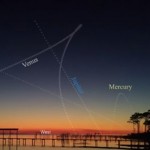
Venus in the evening sky 45 minutes after sunset from December 2014 through August 2015 from LarryKoehn on Vimeo.
Larry Koehn of the wonderful website shadowandsubstance.com dropped us a note about a super cool astronomy animation. It shows the much-anticipated apparition of the sky’s brightest planet – Venus – in the evening sky in 2015. He wrote:
I have animation up of Venus in the evening sky at exactly 45 minutes after sunset from December 10 through August 3rd. The animation is at a frame rate of one-day-per-frame for 238 days. You can also see Mercury, Mars and Jupiter entering the scene at various points. Mercury is interesting for showing up twice, since it too is an inferior planer like Venus. I inserted a small graphic showing Venus near the bottom of the screen showing what Venus will look like through a small telescope at the same frame rate.
To me, it’s like watching a celestial roller-coaster in the sky.
If you watch the skies, you know Venus was visible before dawn for much of 2014. It was a morning object until around early September, when it disappeared in the glare of sunrise. Venus was most nearly behind the sun – as seen from our earthly perspective – on October 25.
Beginning in early December, Venus has made a steady climb back into the evening sky visible from around the globe. Now many are beginning to see it – and captured its photo. Its evening appearance in our sky will peak in northern summer 2015. Larry wrote on his Vimeo page:
From now through August, Venus will come closer and closer to the Earth with it reaching inferior conjunction on August 15, 2015. But before reaching that point, Venus will reach greatest elongation east on June 6. Around May 10, Venus will be the furthest from the horizon.Venus will be in conjunction with Mercury on January 11, then Mars on February 22, and finally with Jupiter on July 1.
Thank you for sharing your great animation, Larry Koehn!
Visit Larry Koehn’s website, shadowandsubstance.com
Bottom line: A new animation shows 238 days of the sky’s brightest planet, Venus, coming back to your evening sky in late 2014 and 2015. You can also see the planets Mercury, Mars and Jupiter enter the scene at various points.
from EarthSky http://earthsky.org/space/animation-shows-venus-in-evening-sky-late-2014-and-2015

Venus in the evening sky 45 minutes after sunset from December 2014 through August 2015 from LarryKoehn on Vimeo.
Larry Koehn of the wonderful website shadowandsubstance.com dropped us a note about a super cool astronomy animation. It shows the much-anticipated apparition of the sky’s brightest planet – Venus – in the evening sky in 2015. He wrote:
I have animation up of Venus in the evening sky at exactly 45 minutes after sunset from December 10 through August 3rd. The animation is at a frame rate of one-day-per-frame for 238 days. You can also see Mercury, Mars and Jupiter entering the scene at various points. Mercury is interesting for showing up twice, since it too is an inferior planer like Venus. I inserted a small graphic showing Venus near the bottom of the screen showing what Venus will look like through a small telescope at the same frame rate.
To me, it’s like watching a celestial roller-coaster in the sky.
If you watch the skies, you know Venus was visible before dawn for much of 2014. It was a morning object until around early September, when it disappeared in the glare of sunrise. Venus was most nearly behind the sun – as seen from our earthly perspective – on October 25.
Beginning in early December, Venus has made a steady climb back into the evening sky visible from around the globe. Now many are beginning to see it – and captured its photo. Its evening appearance in our sky will peak in northern summer 2015. Larry wrote on his Vimeo page:
From now through August, Venus will come closer and closer to the Earth with it reaching inferior conjunction on August 15, 2015. But before reaching that point, Venus will reach greatest elongation east on June 6. Around May 10, Venus will be the furthest from the horizon.Venus will be in conjunction with Mercury on January 11, then Mars on February 22, and finally with Jupiter on July 1.
Thank you for sharing your great animation, Larry Koehn!
Visit Larry Koehn’s website, shadowandsubstance.com
Bottom line: A new animation shows 238 days of the sky’s brightest planet, Venus, coming back to your evening sky in late 2014 and 2015. You can also see the planets Mercury, Mars and Jupiter enter the scene at various points.
from EarthSky http://earthsky.org/space/animation-shows-venus-in-evening-sky-late-2014-and-2015

Aucun commentaire:
Enregistrer un commentaire